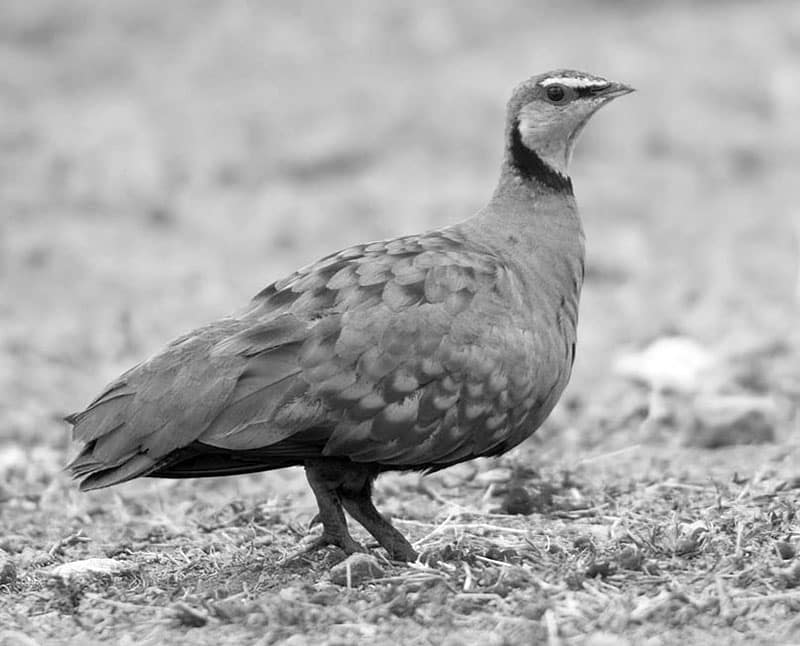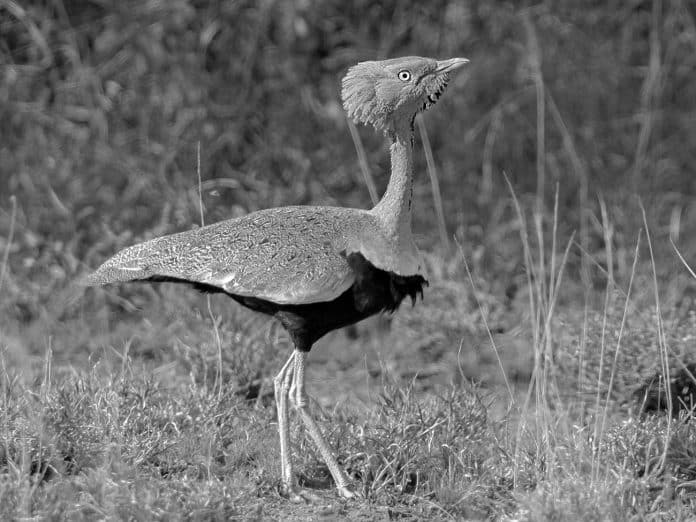Buff-Crested Bustard in Tanzania: A Display of Feathery Pomp
Introduction to the buff-crested bustard
The buff-crested bustard is a magnificent bird species found in Tanzania, showcasing its feathery pomp in the vast savannahs and grasslands of this East African country. This unique bird, scientifically known as Lophotis gindiana, is renowned for its striking appearance and captivating courtship displays. In this article, we will delve into the habitat, physical characteristics, behavior, breeding rituals, threats, conservation efforts, and tips for spotting and photographing the buff-crested bustard in Tanzania. So, grab your binoculars and join us on this avian adventure!
Habitat and distribution of the buff-crested bustard in Tanzania
The buff-crested bustard thrives in the open grasslands, arid savannahs, and shrubby areas of Tanzania. It prefers habitats with short grasses, as they provide ample visibility for foraging and evading predators. This bird species can be found in various regions of Tanzania, including Serengeti National Park, Tarangire National Park, Ngorongoro Conservation Area, and Ruaha National Park. These protected areas offer a suitable environment for the buff-crested bustard, ensuring its survival and providing opportunities for wildlife enthusiasts to observe this magnificent creature in its natural habitat.
Physical characteristics and behavior of the buff-crested bustard
The buff-crested bustard is a large bird, measuring approximately 55-60 centimeters in length and weighing around 2 kilograms. Its most distinctive feature is the buff-colored crest on its head, which stands erect during courtship displays. The male and female buff-crested bustards exhibit sexual dimorphism, with the male sporting a black-and-white striped neck and a strikingly patterned body, while the female has a more subdued plumage. Both genders have a long neck, sturdy legs, and a robust body, enabling them to walk and run swiftly across the grasslands.
In terms of behavior, the buff-crested bustard is primarily diurnal, meaning it is active during the day. It is a ground-dwelling bird that forages for food, consisting mainly of insects, small reptiles, and seeds. The buff-crested bustard has a distinct feeding strategy, using its strong beak to probe the soil and catch prey items. It is known for its solitary nature, often seen alone or in pairs. However, during the breeding season, males engage in flamboyant displays to attract mates, showcasing their elaborate plumage and performing elaborate dances.
Breeding and mating rituals of the buff-crested bustard
The breeding season of the buff-crested bustard typically occurs during the rainy season in Tanzania, which spans from November to April. During this time, male buff-crested bustards engage in extravagant courtship displays to impress potential mates. These displays involve puffing up their chests, extending their crests, and leaping into the air while emitting deep booming calls. These elaborate performances are a testament to the male’s fitness and serve as a visual spectacle for both females and rival males.
Once a female is enticed by a male’s display, they engage in a ritualized dance, circling each other and bobbing their heads. If the female is receptive, mating occurs. The female lays her eggs in a shallow depression on the ground, skillfully camouflaging them with nearby vegetation. The eggs are incubated for approximately 25-30 days, and both parents take turns to ensure their safety. Once hatched, the chicks rely on their parents for protection and food until they are independent enough to venture out on their own.
Threats and conservation efforts for the buff-crested bustard in Tanzania
Despite its captivating presence, the buff-crested bustard faces several threats to its survival in Tanzania. Habitat loss due to agricultural expansion, human settlements, and climate change poses a significant risk. Additionally, the illegal pet trade and hunting for feathers and meat further exacerbate the population decline of this species. Moreover, the buff-crested bustard is susceptible to disturbance from vehicles and human activities, which can disrupt their breeding and foraging behaviors.
To combat these threats, various conservation organizations and government agencies are actively involved in protecting the buff-crested bustard in Tanzania. Efforts include the creation and management of protected areas, community education and awareness programs, and the enforcement of anti-poaching measures. Furthermore, research initiatives are focused on understanding the species’ ecology, breeding patterns, and migration routes to inform conservation strategies. These combined efforts aim to safeguard the future of the buff-crested bustard and ensure its continued presence in the Tanzanian landscape.
Tips for spotting and photographing the buff-crested bustard in Tanzania
Spotting and photographing the buff-crested bustard in Tanzania can be a rewarding experience for birdwatchers and wildlife photographers. Here are some tips to enhance your chances of spotting this magnificent bird:
- Choose the right habitat: Visit the grasslands and savannahs of Tanzania, particularly the protected areas where the buff-crested bustard is known to inhabit.
- Be patient and observant: The buff-crested bustard is a master of camouflage, so keen observation skills are essential. Look for movement or listen for its distinctive calls.
- Respect their space: Keep a safe distance from the birds to avoid causing stress or disturbance. Use binoculars or telephoto lenses to get a closer view.
- Time your visit: The breeding season, which coincides with the rainy season, offers the best opportunity to witness the buff-crested bustard’s courtship displays and nesting behavior.
- Join guided birdwatching tours: Local guides and birdwatching experts can provide valuable insights and help you navigate the best locations for spotting the buff-crested bustard.
By following these tips, you can increase your chances of encountering this regal bird and capturing its feathery pomp through your lens.
Other bird species found in the same habitat as the buff-crested bustard
Tanzania is a birdwatcher’s paradise, boasting a diverse avian population. While searching for the buff-crested bustard, you may also encounter other fascinating bird species that share its habitat. Some notable examples include:
- Secretary Bird (Sagittarius serpentarius): With its distinctive appearance and impressive hunting skills, this bird of prey is a sight to behold.
- Kori Bustard (Ardeotis kori): As one of the heaviest flying birds, the Kori Bustard is known for its elaborate courtship displays and large size.
- Yellow-throated Sandgrouse (Pterocles gutturalis): This ground-dwelling bird is recognized by its striking yellow throat and intricate plumage patterns.

These are just a few examples of the many bird species that coexist with the buff-crested bustard in Tanzania. Exploring the diverse avian life in this region will undoubtedly enrich your birdwatching experience.
Best time of year to visit Tanzania for birdwatching
Tanzania offers exceptional birdwatching opportunities throughout the year, but the best time to visit depends on your specific interests. If witnessing the courtship displays and breeding rituals of the buff-crested bustard is your goal, then the rainy season (November to April) is ideal. During this period, the landscape transforms, and bird activity reaches its peak. However, if you prefer a more comfortable climate and a chance to witness migratory species, the dry season (May to October) is recommended.
Recommended birdwatching tours and guides in Tanzania
To make the most of your birdwatching adventure in Tanzania, consider joining guided tours led by experienced birdwatching experts. These professionals possess in-depth knowledge of the local bird species, their behavior, and the best locations for sightings. Some reputable birdwatching tour operators in Tanzania include:
- Tanzania Birding Tours: This tour operator specializes in customized birdwatching tours, tailoring the itinerary to your preferences and ensuring an immersive experience.
- Nature Expeditions: With a team of knowledgeable guides, Nature Expeditions offers birdwatching tours that combine wildlife encounters and cultural experiences, providing a holistic adventure.
By opting for guided tours, you can maximize your chances of spotting the buff-crested bustard and other avian wonders of Tanzania.
The buff-crested bustard in Tanzania is a true spectacle of nature, captivating birdwatchers and wildlife enthusiasts with its feathery pomp and elaborate courtship displays. Although facing threats to its survival, conservation efforts and responsible tourism practices strive to safeguard this magnificent species. By venturing into the grasslands and savannahs of Tanzania, armed with knowledge and patience, you can witness the enchanting beauty of the buff-crested bustard and its fellow avian inhabitants. So, pack your binoculars, embark on a birdwatching journey, and be amazed by the vibrant avian life that calls Tanzania home.
For more articles related to Wildlife in Tanzania (Animals), click here!


































